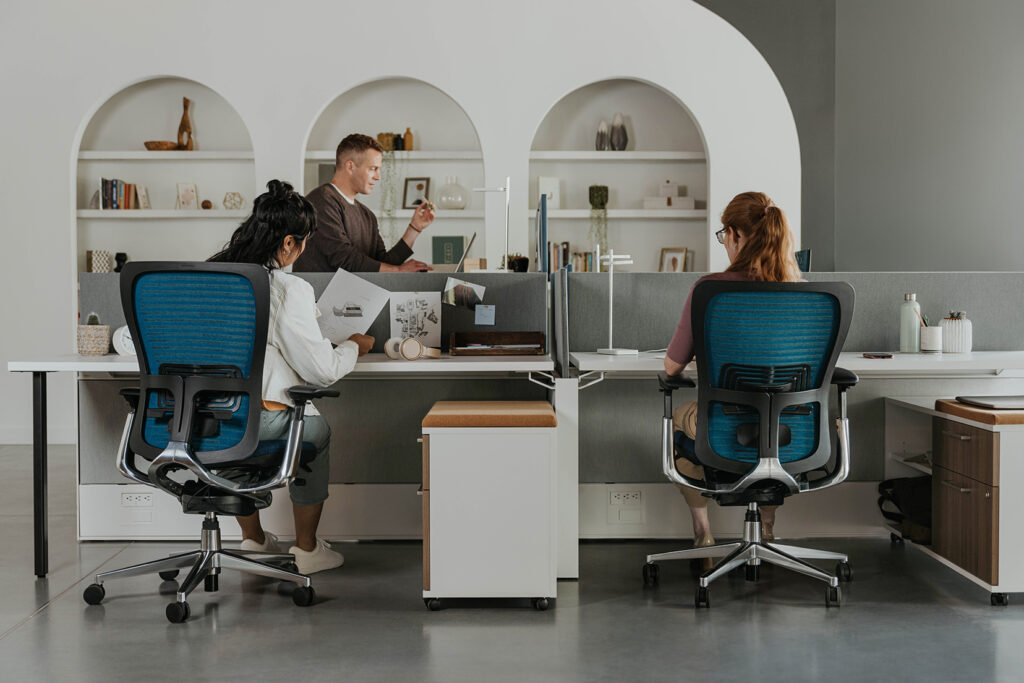Benefits of Workplace Ergonomics

A more ergonomic design is currently one of the top trends in office design. As more companies begin embracing the benefits of workplace ergonomics, others wonder if they should follow suit.
Whether your company is introducing a hybrid work policy, accommodating new technology or refreshing your company culture, consider taking advantage of the benefits of ergonomics in the workplace to improve your space and boost employee productivity.
What Is Workplace Ergonomics?
Workplace ergonomics is the study and improvement of a worker’s movement within their work environment. An ergonomic workplace supports employees’ natural movements and improves their physical well-being while at work. It might require reconfiguring office space, including more comfortable chairs and desks or adding furnishings that allow employees to be physically active during their day.
Three primary considerations go into workplace ergonomics:
- The effort required for a task
- The repetitiveness of a task
- The postures adopted while doing a task
One survey of executives found that of those planning an office redesign, 17.7% plan to optimize their floorspaces before employees return to the office. You should always consider workplace ergonomics, especially when redesigning your office to comply with new requirements. As the expectations for a space change, so should the ergonomics.
How Can Workplace Ergonomics Benefit Your Business?
Consider the following ways that improving your workplace ergonomics can help your business:
Reduces Costs
One of the most significant positives of workplace ergonomics is that it limits the risk factors for injuries, saving companies considerable workers’ compensation costs.
Employee injuries impact the company’s overall profitability. For example, employee strains cost companies over $67,000in direct and indirect expenses. Reducing workplace strains through improved ergonomics translates into considerable savings.
In a comprehensive review of 40 reports, offices using ergonomic interventions reduced injuries from work-related musculoskeletal disorders by an average of 61%. Improving ergonomics also led to an 88% reduction in lost workdays and a 100% reduction in restricted workdays. Overall, companies saw a 78% return on investment for their ergonomics interventions and a payback period of 0.4 years.
Improves Productivity
Workplace ergonomics benefits employees’ productivity as well. The goals of workplace ergonomics are to:
- Improve employee posture.
- Reduce movements needed for tasks.
- Enable employees to use less force to complete an action.
When an office improves its ergonomics, employees can work more efficiently. Employees can access the tools and areas they need with little physical strain and use fewer movements to do their work. In fact, research shows that better office ergonomics can increase productivity by 17%.
Ergonomics also improves productivity by allowing employees to work in the most comfortable position to reduce muscle strain. Sitting at work all day can lead to muscle fatigue, increased stress on the lower back and muscle deconditioning. You can also improve employee productivity through active furnishings like treadmill desks, bike chairs, adjustable height desks and yoga ball chairs to encourage physical activity while working. According to the Centers for Disease Control (CDC), being physically active helps adults maintain better cognitive function.
Improves Quality of Work
The benefits of ergonomics extend from the employee to their work. Part of workplace ergonomics is eliminating hazards and making employees more comfortable. Employees who feel physically supported to perform tasks without muscle strain or fatigue can spend more time focusing on their work.
In contrast, employees who face fatigue in their office space may become frustrated and distracted from their tasks. Employees who have to strain to perform their work might also complete their jobs to a lower standard. Cutting corners can lead to other safety or quality issues.
Providing the right office layout and furnishings for your employees is essential to improving their quality of work. Workplace ergonomics reduce workers’ fatigue, aches and strains at the office. In a more comfortable environment, workers can redirect their attention to providing high-quality performance.
Increases Employee Engagement
Providing more ergonomic furnishings in your office can also promote employee engagement. An ergonomic workplace meets employees’ physical needs by giving them a comfortable place to work. Consider the ways workplace ergonomics can improve your employees’ interest and involvement in their tasks:
- Ergonomics removes distractions: Fatigue and strain take a toll on workers of every kind. Neck strain and backaches make it challenging to perform a task to the best of your ability. Employees can become more engaged when they no longer have to worry about the fatigue they experience at work.
- Ergonomics shows employees you value them: Employees are more loyal to companies that value them. Enhancing your employees’ health increases their satisfaction with their work, and your employees will notice your efforts to improve their well-being and safety. Improving workplace ergonomics can boost your team’s morale, leading to greater motivation.
- Ergonomics reduces absenteeism: Boosting ergonomics in the office can decrease absenteeism by 46%. By creating an environment that supports rather than hinders your employees’ everyday tasks, you make your office an inviting place and your employees may even be more willing to go the extra mile on a job.
Creates a Better Safety Culture
Prioritizing employee health and well-being through workplace ergonomics shows that your company values safety. While the law may require your company to follow specific safety procedures, going beyond your obligations is a great way to demonstrate that safety is of first concern.
Emphasizing health throughout your entire organization — whether in the office, on the warehouse floor or in the manufacturing facility — develops a company culture of safety that positively impacts your employees. In an ergonomic workplace, the company educates employees about potential safety risks and empowers them to improve their health. Employers who provide a safe and healthy workplace enable employees to be and perform at their best.
Read More About Office Culture
Reduces Employee Turnover and Workers’ Compensation Claims
Benefits of ergonomics in the workplace also include reduced employee turnover and workers’ compensation claims. Improving office ergonomics can help you retain your employees. You can display how much you value them by providing them with the tools to be more productive, efficient and comfortable at work.
Creating a more comfortable work environment also helps you grow in other ways. Workplace ergonomics can help you attract the best candidates. Workers are increasingly looking for organizations that invest in them and provide the tools to achieve their personal best. Creating an ergonomic workplace demonstrates that you want your employees to be healthy, safe and productive.
Choose WB Wood for Your Workplace Furniture Solutions
A more ergonomic office makes your workplace healthier for employees and boosts company profitability. When you need to upgrade your office furnishings and layout, turn to WB Wood. We are a furniture project management and procurement company providing furniture services and office space design to help your company achieve its office goals. Contact us today for more information on transforming your office or workspace with better ergonomic solutions.
